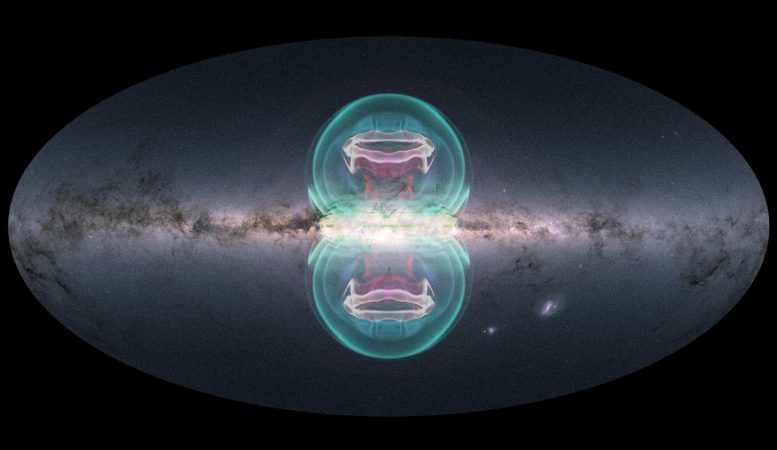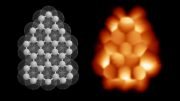
The NASA visualization team created a superposition of an image of the Milky Way, taken by the European Space Agency’s Gaia space observatory, and a visualization of the simulations of the eRosita and Fermi bubbles prepared by Karen Yang (lead author of the study and an assistant professor at the National Tsing Hua University in Taiwan) in cooperation with the co-authors of the paper Mateusz Ruszkowski (University of Michigan) and Ellen Zweibel (University of Wisconsin). Credit: ESA/Gaia/DPAC, CC BY-SA 3.0 IGO
In 2020, the X-ray telescope eRosita took images of two enormous bubbles extending far above and below the center of our galaxy.
Since then, astronomers have debated their origin. Now, a study including University of Michigan research suggests the bubbles are a result of a powerful jet of activity from the supermassive black hole at the center of the Milky Way. The study, published in Nature Astronomy, also shows the jet began spewing out material about 2.6 million years ago, and lasted about 100,000 years.
The team’s results suggest that Fermi bubbles, discovered in 2010, and microwave haze—a fog of charged particles roughly at the center of the galaxy—were formed by the same jet of energy from the supermassive black hole. The study was led by the National Tsing Hua University in collaboration with U-M and the University of Wisconsin.
“Our findings are important in the sense that we need to understand how black holes interact with the galaxies that they are inside, because this interaction allows these black holes to grow in a controlled fashion as opposed to grow uncontrollably,” said U-M astronomer Mateusz Ruszkowski, a co-author of the study. “If you believe in the model of these Fermi or eRosita bubbles as being driven by supermassive black holes, you can start answering these profound questions.”
There are two competing models that explain these bubbles, called Fermi and eRosita bubbles after the telescopes that named them, says Ruszkowski. The first suggests that the outflow is driven by a nuclear starburst, in which a star explodes in a supernova and expels material. The second model, which the team’s findings support, suggests that these outflows are driven by energy thrown out from a supermassive black hole at the center of our galaxy.
These outflows from black holes occur when material travels toward the black hole, but never crosses the black hole’s event horizon, or the mathematical surface below which nothing can escape. Because some of this material is thrown back into space, black holes don’t grow uncontrollably. But the energy thrown from the black hole does displace material near the black hole, creating these large bubbles.
The structures themselves are 11 kiloparsecs tall. One parsec is equivalent to 3.26 light-years, or about three times the distance that light travels over the course of a year. The structures, then, are nearly 36,000 light-years tall.
For comparison, the Milky Way galaxy is 30 kiloparsecs in diameter, and our solar system resides about 8 kiloparsecs from the center of the galaxy. The eRosita bubbles are about two times the size of the Fermi bubbles and are expanded by the wave of energy, or a shockwave, pushed out by the Fermi bubbles, according to the researchers.
Astronomers are interested in the observation of these eRosita bubbles in particular because they occur in our own galactic backyard as opposed to objects in a different galaxy or at extreme cosmological distance. Our proximity to the outflows means astronomers can collect an enormous amount of data, Ruszkowski says. This data can tell astronomers the amount of energy in the jet from the black hole, how long this energy was injected, and what material comprises the bubbles.
“We not only can rule out the starburst model, but we can also fine tune the parameters that are needed to produce the same images, or something very similar to what’s in the sky, within that supermassive black hole model,” Ruszkowski said. “We can better constrain certain things, such as how much energy was pumped in, what’s inside these bubbles and how long was the energy injected in order to produce these bubbles.”
What’s inside them? Cosmic rays, a form of high-energy radiation. The eRosita bubbles enclose the Fermi bubbles, the contents of which are unknown. But the researchers’ models can predict the amount of cosmic rays inside each of the structures. The energy injection from the black hole inflated the bubbles, and the energy itself was in the form of kinetic, thermal, and cosmic ray energy. Of these forms of energy, the Fermi mission could only detect the gamma-ray signal of the cosmic rays.
Karen Yang, lead author of the study and an assistant professor at the National Tsing Hua University in Taiwan, began working on an early version of the code used in the modeling in this paper as a postdoctoral researcher at U-M with Ruszkowski. To arrive at their conclusions, the researchers performed numerical simulations of energy release that take into account hydrodynamics, gravity, and cosmic rays.
“Our simulation is unique in that it takes into account the interaction between the cosmic rays and gas within the Milky Way. The cosmic rays, injected with the jets of the black hole, expand and form the Fermi bubbles that shine in gamma rays,” Yang said.
“The same explosion pushes gas away from the Galactic center and forms a shock wave that is observed as the eRosita bubbles. The new observation of the eRosita bubbles has allowed us to more accurately constrain the duration of the black hole activity, and better understand the past history of our own galaxy.”
The researchers’ model rules out the nuclear starburst theory because the typical duration of a nuclear starburst, and therefore the length of time into which a starburst would inject the energy that forms the bubbles, is about 10 million years, according to study co-author Ellen Zweibel, professor of astronomy and physics at University of Wisconsin.
“On the other hand, our active black hole model accurately predicts the relative sizes of the eRosita x-ray bubbles and the Fermi gamma-ray bubbles, provided the energy injection time is about one percent of that, or one tenth of a million years,” Zweibel said.
“Injecting energy over 10 million years would produce bubbles with a completely different appearance. It’s the opportunity to compare the X-ray and gamma-ray bubbles which provides the crucial previously missing piece.”
The researchers used data from the eRosita mission, NASA’s Fermi Gamma-ray Space Telescope, the Planck Observatory, and the Wilkinson Microwave Anisotropy Probe.
Reference: “Fermi and eROSITA bubbles as relics of the past activity of the Galaxy’s central black hole” by H.-Y. Karen Yang, Mateusz Ruszkowski and Ellen G. Zweibel, 7 March 2022, Nature Astronomy.
DOI: 10.1038/s41550-022-01618-x









its a matter of geometric perspective on the width of the milky way galaxy structure
from the centre out in plan length and width and side elevation height detail
1A the compact centre 120au radius = 240au diameter
Sag a 4.1 +- 0.6 million solar masses confined in a volume with a radius no more than 120au 17 light hours 18 billion kilometres 11 billion miles
2B The first concentric ring the event horizon max width 240au diameter
3C The second concentric ring 30000 light years radius 60,000 light years diameter the bulge of the milky way galaxy
4D The third concentric ring Erosita cocoon bubble 92,000 light years diameter
extend around 14 kiloparsecs 45,661 light years in either direction from the galactic centre for a total of 28 kiloparsecs 92,000 light years engulfing the Fermi bubbles entirely
5E the fourth concentric ring
The rest of the spiral arms of the milky way galaxy
6F the fifth concentric ring
Interstellar gas and dust debris stars falling into the spiral arm regions
So one event 2,600,000 to 2,500,000 caused the two bubbles Fermi and erosita
But one would presume looking at the geometric model
1A interior with 3.5 to 4.1 million solar masses rotating and gryating at speeds close to the speed of light would emit gamma ray bursts of laser beam intensity 50 au across and a million light years long not shown or listed
Followed by as you say
2B the event horizon wall with stellar O B A stars being ground to pulp 2,600,000 2,500,000 years ago and by osmosis process absorbed and repelled and blasted all the way along the event horizon wall 720au circumference towards the apex of the Fermi bubble zenith
3C and the energy created along the 720au event horizon circumference and 10,000 light years long causes a cascading down like a fountain spray of 9 kiloparsec 30,000 light years radius of dust dirt and debris to form the 29354 light years 9 kiloparsecs tall Fermi bubble as illustrated above
4D the third concentric ring 90,000 light years diameter
The Rosita bubble width with a height of 60,000 light years see 7F below
5E the fourth concentric ring
The rest of the spiral arms of the milky way galaxy
6F the fifth concentric ring
The interstellar stuff
7F the bulge of the milky way galaxy full of stellar stars O B A F G K M but also supernovaed ones plus the all important extra black hole sources that drive the formation of the erosita bubble and the expansion rate of the erosita bubble to 90,000 light years width
So all in all i would have though we was looking for
1a gamma ray source i
2B event horizon xray source soft and hard causing the Fermi bubble with a volume metric of 10,000 light years height x 50 light year wide cylinder walls with a hollow section 50 light years on the interior where no matter can escape horizontally
X ray source soft i and hard ii
3C Fermi bubble flame caused by the friction and osmosis of stellar O B A stars smashing against the event horizon outside surface wall at 240au diameter and being ejected polar high to the tip of the Fermi bubble flame section just like a Bunsen burner flame effect x ray source iii and gamma ray source ii as u have stated
4D Rosita bubble from milky way bulge multiple black hole sources xray source iv and gamma ray source iii the expansion cause of the Rosita bubble which you are not detailing
That completes the height width and length of our 3d milky way galaxy and your 2,500,000 timeline gives us our fourth dimension in space and time a trajectory that allows einsteins space time continuum live on in march 2022 ever present changing moment of time
Black holes don’t get an unlimited supply of matter to “feed” on their whole lives. If they did, they wouldn’t be able to produce gamma rays with the matter. The explanation as to why these bubbles exist is extremely simple.
Our galaxy began its life as a single black hole. Black holes are made of quark plasma which is invisible and can make shapes. They are invisible because they only release gamma rays. The rotation our galaxy possesses spread the plasma into a disk with a bulbous center. The center eventually separated from the disk and our black hole was born. The quark plasma disk was left to create all the solar systems. This “Fermi bubble” is the black hole that has not cooled as much as the rest of the galaxy because it is the most massive part of it. The solar systems are created the same way as our galaxy was but they have cooled much faster because there is much less matter involved. Our solar system was created exactly like our galaxy out of an initial mass of quark plasma. This is the way all orbits in our universe are formed. Even our planets and corresponding moons and rings were formed out of an initial mass of this plasma.
Quark plasma is the most efficient reaction in the universe. Once quarks are separated from a sufficient enough reaction, it is the density of the dark matter of space that keeps the quarks apart. Consequently, the dark matter is accelerated out of the reaction as gamma rays with the strong force between the quarks. That is the energy that makes our universe seem so timeless and is why unexplained gamma rays are emanating from this bubble.
If our galaxy wasn’t spinning, an elliptical or irregular galaxy would be formed like so many we see. If the mass isn’t spinning, the matter leaves the galaxy from the center in all directions hiding the black hole in the center. Quark plasma begins its life optically invisible but eventually starts creating neutrons on its surface which gives it its first light. These neutrons then break down to the first hydrogen the mass will possess. At that point, the constantly forming neutrons fuse with the hydrogen to form the first helium atoms the mass will possess using the beta minus decay reaction. This process continues creating heavier elements making the mass get darker until a crust forms and the light goes out. This is when an atmosphere is allowed to develop.
It is going to take a massive paradigm shift to explain everything we see. Current theories make everything scientists see in our universe confusing and are currently telling scientists that fusion is the obvious energy of the universe when it isn’t. All the galaxies gained all their initial energy 13.8 billion years ago when two objects collided at an astronomical speed in an already existing, static universe. They are expanding because they are shrapnel from this event. Some galaxies were spinning and some were not. Ours was and that’s the reason ours looks the way it does.
There is only one way to finally understand all the aspects of our universe and that is to start a new paradigm that states gravity didn’t create the energy we see, a collision did. Our universe simply turned itself into a gargantuan particle collider no different than the ones we have on Earth. The only difference is the two objects colliding were much bigger. The result was the exact same as the particle colliders in which the collision created quark plasma shrapnel. That is where the galaxies got their energy and why the are expanding. All the laws of physics are followed perfectly. It is the only method our universe possesses to create what we see.
Just to confirm where that particle collider exists
Sag a 4.1 +- 0.6 million solar masses confined in a volume with a radius no more than 120au 17 light hours 18 billion kilometres 11 billion miles
120 au outside event horizon wall from which stellar matter is absorbed
50 au inside event horizon wall from which no matter may exit
Implies 70 au thick event horizon wall that has a 720 au circumference with a height of 4,000,000 solar suns minimum and at average lets say the height of milky way galaxy bulge 10,000 light years
So this object in a cylinder shape 70 au wall 720 au circular cylinder shape and 10,000 light years long is the hadron particle collider at the centre of our milky way and probably at the centre of most galaxies out there
And also a worm hole for travelling from the south polar point of the milky way galaxy central bulge to the north polar point of the milky way galaxy 10,000 light years long
As against travelling around the galaxy edges and fringes which could take you 270,000,000 light years to do its a great shortcut if you ask me if you could last 10,000 or more years in existence in einsteins space time continuum